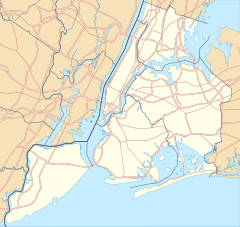Family Red Apple boycott facts for kids
The Family Red Apple boycott was a big protest that started in January 1990. It was also known as the "Red Apple boycott" or "Flatbush boycott." This protest lasted for about 18 months. It focused on stores owned by Korean Americans in Brooklyn, New York City.
The protest began at a store called Family Red Apple, located at 1823 Church Avenue in the Flatbush area. The New York Times newspaper even called these protests "racist and wrong." Over time, the boycott spread to other stores in and around the neighborhood.
This protest happened during a tough economic time in the early 1990s. Life was harder for many people in New York City's poorer neighborhoods. The boycott also showed tensions between different groups, like African Americans and American Jews. It even affected how people felt about the city's mayor, David Dinkins.
Later in the 1990s, things got better in New York City. Crime and unemployment went down. Relationships between different communities, including Black, Asian, and Jewish residents, generally improved. The Family Red Apple boycott itself ended peacefully in 1991. The store even got many customers back after the original owner left.
Contents
What Started the Boycott?
The Incident at Family Red Apple
The boycott began because of a disagreement at the Family Red Apple store. A Haitian American woman named Giselaine Fetissainte said that a Korean-American shopkeeper and other employees searched her and hit her. The shopkeeper, however, said that the woman had not paid for items and that no one attacked her.
This event quickly led to protests. Two local leaders, Robert "Sonny" Carson and George Edward Tait, helped organize the boycott. Robert Carson was a well-known black nationalist activist. People also started to criticize New York City's Mayor David Dinkins. They felt he was not doing enough to stop the protests.
Tensions Rise During the Boycott
The protests became very tense. At one point, Robert Carson warned that the boycott could get worse. Police even found some dangerous items on nearby rooftops. In one case, a protester attacked a man from Vietnam. Other protesters shouted for Koreans to leave. While people worried about serious racial problems, the situation did not get as bad as some feared.
A judge in New York City ordered the protesters to stay at least 50 feet (about 15 meters) away from the Korean stores. However, the NYPD did not enforce this order. They said it was a private disagreement. Mayor Dinkins's office tried to help both sides find a solution.
After eight months, the protesters were still not cooperating. Mayor Dinkins decided to try and help by personally shopping at the grocery store. The Korean store owner was happy about this. But the protesters shouted at the mayor. Even with the mayor's effort, the boycott did not end right away.
Other Stores Affected
The Family Red Apple store was not the only one that faced protests. Seven months after the first boycott began, another similar protest started in Brownsville, which is another neighborhood in Brooklyn. This time, Mayor Dinkins's team reacted more strongly to the situation.
How the Boycott Ended
The Family Red Apple boycott finally ended when the store's owner sold his lease to another Korean-American person. The store reopened just three days later. After that, many customers started coming back to the store.
Mayor Dinkins and the Boycott
Many people in the news criticized Mayor Dinkins for how his team handled the boycott. Some said it was not just one protest but an unfair attack on a Korean-owned store.
Leaflets were handed out that told Black people to "boycott all Korean stores." They also told people to avoid shopping with "people who do not look like us."
There was also some blame being passed around:
- The mayor blamed the Brooklyn District Attorney.
- A Deputy Mayor said that boycotts should only be a last choice for upset customers. They should never be used against entire groups of people.
Mayor Dinkins's Thoughts Later
In his book, Mayor Dinkins wrote about the boycott. He said people criticized him for not crossing the protest line to show support for the store. He explained that he wanted to help solve the problem. However, he felt that his presence might have made things worse at that time. He believed his involvement would do more harm than good.
Dinkins also wrote that he might have waited too long to get involved. He had faith that the court system and people themselves could find good solutions. But he wondered if he was wrong about that.
Looking Back at New York's History
This kind of tension had led to boycotts of several Korean stores since 1984. Seven months after the Family Red Apple boycott started in Flatbush in January 1990, the New York Times wrote about the Brownsville case in August. The newspaper noted that at least the Mayor acted quickly that time. He also admitted that the protests likely had a racial reason behind them.
Images for kids



